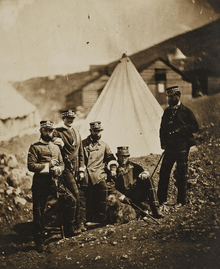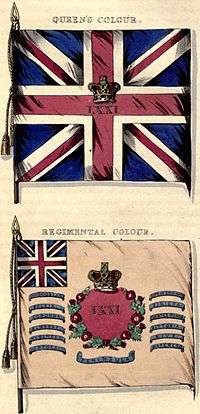71st (Highland) Regiment of Foot
| 71st Regiment of Foot | |
|---|---|
|
Regimental colours | |
| Active | 1758–1881 |
| Country | United Kingdom of Great Britain and Northern Ireland |
| Branch | British Army |
| Type |
Highland Regiment Infantry |
| Role | Light Infantry |
| Battle honours |
Cape of Good Hope (1806) Rolica Vimiera Corunna Almaraz Vittoria Peninsula Waterloo Sevastopol |
The 71st Regiment of Foot was a Highland regiment in the British Army, which in 1881 became the 1st Battalion, Highland Light Infantry .
History
First formation
An earlier 71st Regiment of Foot was formed in 1758 from the 2nd Battalion, 32nd Regiment of Foot. Soon after formation the 71st Foot was part of a raid on the French coast at Cherbourg during the Seven Years' War. After taking the fort and destroying the docks the regiment reboarded and returned to England before it took part in a similar raid on Belleisle in 1761. In 1763 the 71st became a Regiment of Invalids before disbanding in 1768.
Fraser's Highlanders
Main article 78th Fraser's Highlanders
Main article 71st Regiment of Foot, Fraser's Highlanders
Fraser's Highlanders were formed from independent Highland companies in 1757 before becoming the 78th (Highland) Regiment of Foot in 1758. Later on that year the Fraser's Highlanders were shipped to Nova Scotia from where they took part in the French and Indian War . They fought at the Battles of Louisburg (1758), Quebec (1759) and Sainte Foy (1760). In 1763 the 78th disbanded at Quebec where most of its men transferred to the Royal Highland Emigrants.
After the outbreak of the American War of Independence in 1775, Simon Fraser, Master of Lovat, was authorised to raise the 71st (Highland) Regiment of Foot. With companies mustered in Inverness and Stirling, two battalions were formed and in April 1776 the 71st Highlanders, known informally as 'Fraser's Highlanders', sailed from Glasgow as part of the reinforcement of British forces in America. Elements of both battalions, totalling about 400 men, were captured by rebel naval forces in actions both on the high seas and in Boston Harbour. However, most of the regiment arrived safely off New York in August 1776 and the remaining companies were brigaded into three provisional battalions for the campaigns 1776 and 1777.
After the capture of Philadelphia, the 71st, having been reduced by sickness, was sent back to New York where the Regiment was joined by replacements from Scotland and resumed its original two-battalion structure. In 1778, further companies were raised in Scotland and later that year, the 71st was sent south to campaign in Georgia and the Carolinas. Although both battalions were again considerably reduced by sickness, a skeleton battalion structure was maintained. The 1st Battalion was effectively destroyed at Cowpens in January 1781 with many men being taken prisoner. The Regiment was formed onto a single battalion which went into captivity after Cornwallis' surrender at Yorktown in October 1781.
The 71st Regiment of Foot or 'Fraser's Highlanders' served in both the Northern and Southern Campaigns, participating in these major battles: Brooklyn (1776), Brandywine (1777), Savannah (1778), Briar Creek (1779), Siege of Savannah (1779), Siege of Charleston (1780), Camden (1780), Cowpens (1781), Guilford Courthouse (1781), and Yorktown (1781).
In April 1782 the remaining battalions of the 71st Regiment were re-formed into two distinct Regiments, the 71st and the Second 71st.[1] The first of these two new units consisted of the remaining men of the original regiment, who had not been killed in action or captured, and numbered only 189 when it set sail from Charleston with the evacuation of all British forces in December 1782.[2]
The 2nd 71st was disbanded in 1783 and the 71st Regiment was disbanded in 1786.
MacLeod's Highlanders
The MacLeod's Highlanders were raised from an independent Highland regiment by John Mackenzie, Lord MacLeod, son of the Earl of Cromartie, in 1777 as the 73rd (Highland) Regiment of Foot (MacLeod's Highlanders). Lord MacLeod was the first commander of the regiment, adopting the “Macleod of Harris tartan” that was originally a Mackenzie tartan.
The 1st battalion served in the East India Campaign. Between 1778 and 1786 the 1st/73rd Highlanders saw service in Gambia in West Africa and in the Mysore War in India where the battalion was completely destroyed during the Battle of Conjeveram on 10 September 1780.
A 2nd Battalion was raised in 1778, serving from 1780 in Gibraltar where they took part in the Great siege of the fortress before disbanding in 1786 after they were absorbed into the 1st Battalion in 1783 under Colonel George Mackenzie.[3]
In 1786 the regiment was redesignated as the 71st (Highland) Regiment of Foot (MacLeod's Highlanders). .
71st Highlanders

After redesignation the 71st Highlanders carried on fighting in India where they fought in the Battle of Pondicherry in 1793 and at Ceylon in 1795. In 1798 after a number of years on active service the effective troops left in the regiment were transferred to the 74th Regiment of Foot and the remainder returned to Scotland by 1802. A 2nd Battalion was formed in 1804. Over the next few years the regiment changed its name a number of times before becoming the 71st (Glasgow Highland Light Infantry) in 1809 and finally 71st (Highland) Regiment of Foot (Light Infantry) . In order to become Light Infantry the regiment changed the way it trained, marched and fought.
1st/71st Highlanders
The 1st Battalion left Britain for the Cape of Good Hope in 1806 where they were involved in minor actions. In June 1806 they were shipped to South America where they were involved in the disastrous expedition against Buenos Aires by Sir Home Popham. The city was actually captured but later the inhabitants rose against the small British force and took them prisoner. The 1st/71st was one of the battalions captured. Two battalion flags or Regimental Colours were also captured. On the 21st. of April 1808 the regiment received new colours instead of those they had surrendered at Buenos Aires. The colours were presented by General Floyd, a veteran officer.[4]
After reforming the battalion they sailed in 1808 for Portugal where they took part in General Moore's advance into Spain and disastrous retreat out of Spain which ended with Moore's victory at Corunna.
Upon leaving Spain the battalion was sent in 1809 on the Walcheren Campaign. In 1810 the battalion was back in Iberia. They fought all the way through the Peninsular War, in the Battle of Vitoria they were to hold the extreme right of the line and were ambushed at the amphitheatre and massacred by two French regiments, 40 surrendered and around 200 where dead or wounded. Also were at the Battle of Waterloo in 1815 as part of the 3rd Brigade in Maj.General Sir Henry Clinton's 2nd Division. The 1st/71st lost 16 officers and 171 men killed and wounded at Waterloo.
2nd/71st Highlanders
The 2nd Battalion was raised in 1804 and spent the whole of the Napoleonic War based in Scotland functioning as a training battalion supplying replacement troops to the 1st Battalion. The 2nd/71st was disbanded in 1815.
19th-Century
After Waterloo the usual tours of duty around the British Empire followed, serving in Canada,[5] Bermuda, the West Indies and Corfu before the Crimean War broke out in 1854. The 71st Highlanders were at the Siege of Sevastopol from September 1854 and the Kerch Expedition to Eastern Crimea from May to June 1855.
The 71st were sent to India in 1858 where they helped suppress the Sepoy Rebellion in Central India. By 1863 the regiment was based on the North West Frontier where they fought in the Battle of Ambela.
In 1873 the regiment was stationed in Sri Lanka.[6]
Amalgamation
The 71st Highlanders moved back to Britain in 1865. They were stationed there when the Childers Reforms were introduced in 1881, which saw the 71st paired with the 74th (Highland) Regiment of Foot to form the 1st and 2nd Battalions, Highland Light Infantry .
Battle honours
Battle honours awarded to the regiment were:[7]
- Hindoostan
- Cape of Good Hope 1806
- Peninsular War: Rolica, Vimiera, Corunna, Fuentes d'Onor, Almaraz, Vittoria, Pyrenees, Nive, Orthes, Peninsula
- Napoleonic Wars: Waterloo
- Crimean War: Sevastopol
- Central India
Colonels

Colonels of the regiment were:[7]
71st Regiment of Foot (1758–1763)
- 1758–1763: William Petitot
- Disbanded 1763
71st Regiment of (Highland) Foot (Fraser's Highlanders) (1775–1786)
- 1775–1782: Lt-Gen. Hon. Simon Fraser of Lovat
- 1782–1783: Gen. Alexander Lindsay, 6th Earl of Balcarres
- Disbanded 1786
73rd (Highland) Regiment of Foot (MacLeod's Highlanders)
- 1777–1789: Maj-Gen. John Mackenzie, Lord MacLeod
71st (Highland) Regiment of Foot (MacLeod's Highlanders) - (1786)
- 1789–1803: Gen. Hon. William Gordon of Fyvie
- 1803–1809: Gen. Rt. Hon. Sir John Cradock, 1st Baron Howden
71st (Glasgow Highland Light Infantry) Regiment of Foot - (1809)
- 1809–1824: Gen. Francis Dundas
71st (Highland) Regiment of Foot (Light Infantry) - (1810)
- 1824–1829: Gen. Sir Gordon Drummond, GCB
- 1829–1838: Gen. Sir Colin Halkett, KCB, KCH
- 1838–1841: Lt-Gen. Sir Samuel Ford Whittingham, KCB, KCH
- 1841–1848: Lt-Gen. Sir Thomas Reynell, 6th Baronet, KCB
- 1848–1849: Lt-Gen. Sir Thomas Arbuthnot, KCB [also 9th Foot, 52nd Foot, 99th Foot]
- 1849–1857: Gen. Sir James Macdonell, GCB, KCH
- 1857–1863: Gen. Sir Thomas Erskine Napier, KCB
- 1863–1870: Gen. Hon. Charles Grey
- 1870–1874: Lt-Gen. Robert Law, KCB
- 1874–1880: Gen. Hon. Sir George Cadogan, KCB
- 1880–1881: Gen. John Hamilton Elphinstone Dalrymple, CB
Trivia
Seventy-First High School in Fayetteville, North Carolina is named after the 71st Regiment because many of the Scottish settlers in western Cumberland County were their descendants.
See also
References
- ↑ Letter from War Office to Sir Guy Carleton, 30 April 1782, PRO 30/55/39, document 4519, page 1, National Archives, Kew, United Kingdom
- ↑ List of Transports for the Evacuation of Charleston, 19 November 1782, CO 5/108, folios 37-42, National Archives, Kew, United Kingdom
- ↑ Stuart Reid, ‘Mackenzie, John, Lord Macleod, and Count Cromarty in the Swedish nobility (1727–1789)’, Oxford Dictionary of National Biography, Oxford University Press, 2004; online edn, May 2006 accessed 29 May 2013
- ↑ Lord MacLeod's Highlanders 1800 – 1810
- ↑ Toronto Globe 10 Aug 1850 p. 3.
- ↑ http://www.cgsc.edu/CARL/nafziger/871DAA.pdf
- 1 2 "71st (Glasgow Highland Light Infantry) Regiment of Foot". regiments.org. Archived from the original on 3 January 2007. Retrieved 27 July 2016.
External links
- British Regiments Site
- Clan Fraser Society of Canada
- History of the MacLeod's Highlanders
- Highland Light Infantry
- A Brief History of the 71st Regiment
- Battle of Waterloo
- 71st Highland Light Infantry Reenactment Group
